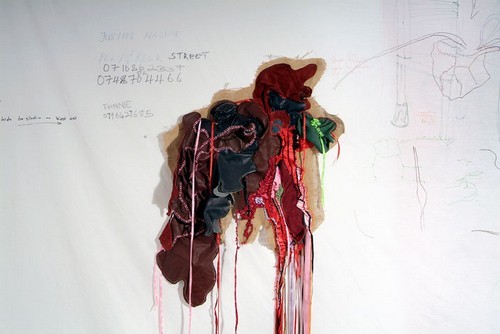Nicholas Hlobo
Uhambo
09 Dec 2008 - 29 Mar 2009

© Nicholas Hlobo
Visual Diary 2008 (detail),
2380 x 15570 mm,
Courtesy of the artist and Michael Stevenson Gallery, Cape Town © Nicholas Hlobo. Photo: Clifford Shain
Visual Diary 2008 (detail),
2380 x 15570 mm,
Courtesy of the artist and Michael Stevenson Gallery, Cape Town © Nicholas Hlobo. Photo: Clifford Shain
Nicholas Hlobo has developed a distinctive body of work, stitching and weaving disparate materials such as ribbon, rubber, gauze and leather to create seductively tactile sculptures and drawings. His works are richly layered, anchored in references to Xhosa culture and the experience of life in post-Apartheid South Africa, while reflecting upon themes of language and communication, gender and sexuality, race and ethnicity.
The process of making is fundamental to Hlobo. He utilises techniques such as stitching and weaving, which are traditionally undertaken by women in South Africa. His choice of materials is similarly charged with meaning. The old and punctured inner tubes of car tyres that he gathers from repair shops in Johannesburg are a symbol of industrialisation and the urban experience. For Hlobo, the rubber has particular significance as an emblem of masculinity, not simply because car ownership in South Africa is a masculine status symbol, but also because the inner tubes resemble condoms. Sexual themes are often implicit in his works through his use of phallus and sperm shapes, and forms resembling orifices, umbilical cords and internal organs.
The satin ribbon that he uses to make his marks on paper, and which literally connects the disparate elements of his sculptures, suggests femininity, domesticity and unification, in contrast to the more ‘masculine’ materials that it binds together. The ribbon, and the way it is used, challenges gender-based assumptions about divisions of labour and introduces a more ambiguous approach to sexuality.
Hlobo always titles his works in his native tongue, Xhosa, an Nguni language widely spoken in South Africa. Attracted to the formal qualities of the grammar, the sounds of the words, and the linguistic flexibility of Xhosa, Hlobo’s use of the language, with all its poetic idioms, proverbs, and double entendres, is as much about defining himself as it is an effort to convey difficult truths and encourage dialogue around complex social issues.
This exhibition presents four recent works by Hlobo, which focus on process and communication. Its title, Uhambo,means ‘The Journey’, referring to the physical and mental process of creating these pieces and the passage of the works from one cultural context to another.
Nicholas Hlobo was born in Cape Town in 1975. He lives and works in Johannesburg.
Nicholas Hlobo: Uhambo is curated by Kerryn Greenberg
The process of making is fundamental to Hlobo. He utilises techniques such as stitching and weaving, which are traditionally undertaken by women in South Africa. His choice of materials is similarly charged with meaning. The old and punctured inner tubes of car tyres that he gathers from repair shops in Johannesburg are a symbol of industrialisation and the urban experience. For Hlobo, the rubber has particular significance as an emblem of masculinity, not simply because car ownership in South Africa is a masculine status symbol, but also because the inner tubes resemble condoms. Sexual themes are often implicit in his works through his use of phallus and sperm shapes, and forms resembling orifices, umbilical cords and internal organs.
The satin ribbon that he uses to make his marks on paper, and which literally connects the disparate elements of his sculptures, suggests femininity, domesticity and unification, in contrast to the more ‘masculine’ materials that it binds together. The ribbon, and the way it is used, challenges gender-based assumptions about divisions of labour and introduces a more ambiguous approach to sexuality.
Hlobo always titles his works in his native tongue, Xhosa, an Nguni language widely spoken in South Africa. Attracted to the formal qualities of the grammar, the sounds of the words, and the linguistic flexibility of Xhosa, Hlobo’s use of the language, with all its poetic idioms, proverbs, and double entendres, is as much about defining himself as it is an effort to convey difficult truths and encourage dialogue around complex social issues.
This exhibition presents four recent works by Hlobo, which focus on process and communication. Its title, Uhambo,means ‘The Journey’, referring to the physical and mental process of creating these pieces and the passage of the works from one cultural context to another.
Nicholas Hlobo was born in Cape Town in 1975. He lives and works in Johannesburg.
Nicholas Hlobo: Uhambo is curated by Kerryn Greenberg
